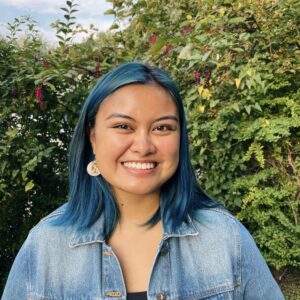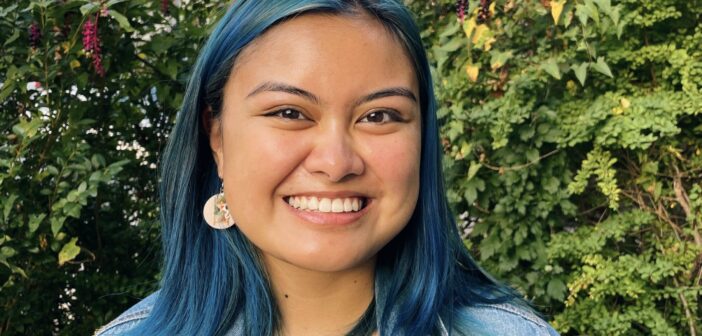
Dom Ocampo ’22
The lack of inclusivity in Lehigh’s curriculum and student organizations is not a secret. According to University Statistics, 61 percent of Lehigh undergraduates are white, making Lehigh a predominantly white institution (PWI). Dom Ocampo, ‘22, who identifies as a pansexual, nonbinary, Asian person, said they do not feel represented on campus – even sometimes within Lehigh’s LGBTQ+ community.
Ocampo said there are not enough resources or focus within Lehigh’s structure to make room for the empathy that is necessary to understand the complex nature of identifying as a queer transgender person of color (QTPOC).
When Ocampo began their college search, they were specifically looking for a school in Pennsylvania where they could study engineering and the arts.
Ocampo said Lehigh’s Integrated Degree in Engineering, Arts and Sciences (IDEAS) program was the only one in the country that spoke authentically to what they wanted to do with their life.
As a high school senior in Pennsylvania, Ocampo was invited by Lehigh’s Office of Admissions to participate in the Diversity Achievers Program (DAP). DAP provides prospective students with the opportunity to spend time on campus through a culturally based, overnight program, according to its website.
Ocampo said all participants were of marginalized identities or lower socio-economic backgrounds. Being surrounded by people that looked like them, and had similar experiences to them gave Ocampo the impression that diversity and all cultural experiences would be accepted on campus.
This impression, as well as Lehigh’s tendency to market themselves as extremely diverse (see: Diversity and Inclusion at Lehigh), was one of the reasons that Ocampo chose to enroll at Lehigh.
“I came into Lehigh thinking that it was a lot more accepting than it was,” they said.
Ocampo said they are grateful for the resources they found after their realization that this wasn’t the case, such as the Pride Center and Students Promoting Equality, Awareness and Knowledge (SPEAK), Lehigh’s gender and sexuality peer education group.
Ocampo said Lehigh’s Department of Theater has also been a safe space for them on campus.
However, being grateful and desiring change are not mutually exclusive.
Being the first in their family to be born in the U.S., Ocampo said it’s important to them to connect to their identity as a Filipino person.
Ocampo also acknowledged the complex family and work roles prominent in Southeast Asian cultures. Ocampo said their identity has allowed them to deconstruct these various roles and explore the history of Filipino mythology, where they have found experiences outside of the gender binary and heterosexual love.
“In a way, identifying the way that I am and being authentic to myself has made me feel more connected to my culture than I have being raised in white America,” they said.
Ocampo said there are also needed conversations within Lehigh’s queer community around white supremacy and the role that it plays in interactions with people of any experience.
The LGBTQ+ community is not exempt from the power dynamics that have preserved a culture dominated by the white and wealthy. The intention of this column has always been to highlight all aspects of the LGBTQ+ experience at Lehigh, and the reality of many QTPOC students’ experiences seem to be that even spaces that are supposed to be safe are susceptible to the prioritization of white voices.
Ocampo knows just three other QTPOC Lehigh students and said that when they do enter spaces, they are not listened to.
Ocampo said they have experienced a lot of harm from people on campus who have similar experiences to them— who they thought were safe to be vulnerable with— because not everyone understands the complex nature of identifying as both queer and non-white.
“When we do show up in groups, we’re dismissed as aggressive or sensitive when really, we’re just trying to be vulnerable and make space for ourselves on campus,” they said.
“I really encourage people who are in spaces that have been called out or people that are in positions that have been questioned to consider why people are speaking up and consider what can be done rather than immediately becoming defensive,” they said.
It’s not always easy to come to terms with the fact that we have caused harm.
“I do understand that it’s really hard to recognize that you’ve made a mistake and that you’ve hurt someone,” Ocampo said. “It’s even harder to recognize that you and your loved ones participate in a structure that was built on that oppression.”
Ocampo said that we should all consider our individual impact before jumping to defend ourselves. Let’s allow each other the basic decency to listen when concerns are addressed and to examine how our own actions are contributing to a campus environment where QTPOC don’t feel respected.
According to Ocampo, queer and trans-inclusive training within the school’s Counseling and Psychological Services, gender-inclusive bathrooms in every building and further education for faculty and staff are other ways in which Lehigh can become more inclusive.
“I hope this institution can reflect on the harm it’s done and change so that people like me, and the friends that I have, who come in as students after us, have a better experience,” they said.






Comment policy
Comments posted to The Brown and White website are reviewed by a moderator before being approved. Incendiary speech or harassing language, including comments targeted at individuals, may be deemed unacceptable and not published. Spam and other soliciting will also be declined.
The Brown and White also reserves the right to not publish entirely anonymous comments.
3 Comments
What is the percentage of the white population in the US? It seems to me that 61% white at Lehigh is reasonably Representative of the general population?
It’s not even the fact that Lehigh “represents the US”. It’s the fact that Lehigh continuously likes to say they’re diverse when they’re not. Lehigh uses BIPOC as diversity tokens and exploits their identities just to make more money. But the second we try to tell them something’s wrong, they ignore our experiences and needs
The U.S. population is 13.4% Black but Lehigh’s student population is 5% Black, so Lehigh isn’t a good representative of the general population. This can also be seen with other racial and ethnic groups. However, the experience Dom shared isn’t really about Lehigh representing the general population. It’s about how Lehigh exploits students of color and isn’t as diverse as they like to claim.